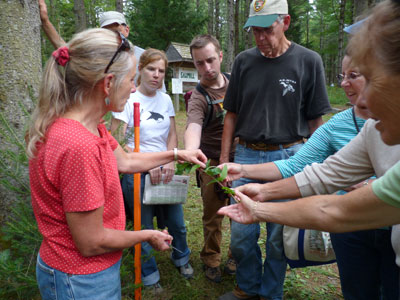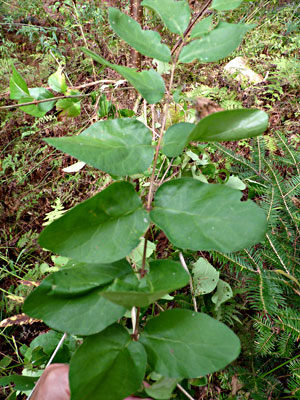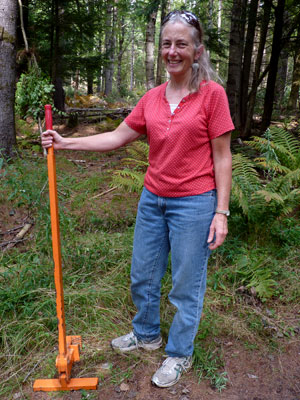 |
| Barrie Brusila of Mid-Maine Forestry showed Japanese honeysuckle, one of several potentially invasive plants in Maine’s woods, to fairgoers at the Common Ground Country Fair and showed how to remove the plant with a powerful tool. English photos. |
 |
 |
Invasive plants haven’t taken over Maine’s woodlands yet, so now is the time to control them, said forester Barrie Brusila of Mid-Maine Forestry in Warren, Maine, during a workshop at MOFGA’s Common Ground Country Fair. She discussed common woody invasives and showed how to remove some using a tool that wrenches plants out of the ground. [2019 update: Weed Wrenches are no longer sold by the manufacturer. The Uprooter is a current replacement. The Extractigator is another. For a review of removing woody invasives with weed-wrench-type tools, visit Ecolandscaping.org]
Japanese honeysuckle (Lonicera japonica) is a shrub with fruit that is not as nutritious for birds as that of the native, noninvasive fly-honeysuckle (L. canadensis). The native plant has solid pith and leaves without hairs, while the invasive has hollow pith, and its leaves tend to be fuzzy. The Japanese honeysuckle coming up along the woods path at MOFGA probably came in with a load of fill. Brusila showed how to secure the lower stem of honeysuckle in the jaws of the Weed Wrench and then use the tool’s leverage to pull out the plant, roots and all. She suspended the pulled plant in the crotch of another tree so that the roots were in the air and the plant would dry out and die.
Japanese barberry (Berberis thunbergii) is a dense shrub with numerous sharp thorns. Brusila wonders if the increase in this plant in the woods is related to the increase in the wild turkey population, as turkeys can spread the seeds. She uses a Weed Wrench to extract Japanese barberry – often pruning the stems back to a low main trunk before using the wrench, to prevent being stabbed by thorns. The best time to look for this plant, she said, is early spring or late fall, since it leafs out before and retains its leaves longer than most other plants. Be sure to remove the entire root system, said Brusila; otherwise the plant can resprout.
Asiatic bittersweet (Celastrus orbiculata) is a difficult vine to get rid of. A common material for making wreaths because of its colorful berries, discarded wreaths can spread the seeds. Control is important, since the vigorous vine can strangle or shade out other plants. Pull the entire root system if possible to prevent resprouting.
Multiflora rose (Rosa multiflora) has numerous small rose hips and nasty thorns. Lop off the top of the shoots, said Brusila, then pull the plants, removing the entire root system.
Autumn olive (Eleagnus umbellata), once recommended for wildlife plantings, thrives on infertile soil as it fixes nitrogen. Pull small plants before they get so large that they are difficult to control. Simply pruning them back can lead to resprouting and thicker growth.
Norway maple (Acer platanoides) can invade forests and, with its dense shade, displace native plants.
Glossy buckthorn (Frangula alnus) and common buckthorn (Rhamnus carthatica) can grow as shrubs or small trees. Repeated cutting or mowing can weaken these plants.
A USDA NRCS (Natural Resources Conservation Service) cost share program, the Wildlife Habitat and Improvement Program (WHIP), helps with invasive species control and planting native shrubs. See www.me.nrcs.usda.gov/programs/WHIP.html.
For more information about invasive species in Maine, see https://umaine.edu/publications/2536e/.
– J E
